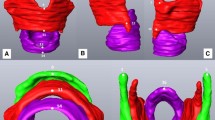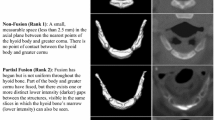Abstract
The aim of this study is to obtain a quantitative anatomical description of the hyoid bone and mandible using three-dimensional computed tomography. Hyoid bones were obtained from a total of 101 cadavers varying in age from 67 to 102 years. The percentage of symmetrical U-type and asymmetrical-type hyoid bones was low compared with symmetrical V type (14.9, 15.8, and 69.3 %, respectively), and no significant sex difference was observed. We found bilateral nonfusion in cadavers of advanced age at a rate of 22.7 % and bilateral complete fusion at a rate of 51.5 %. There were significant differences in metric variables (length and width) between males and females, but no significant differences in width among the different fusion types. There was no significant interaction effect of sex and degree of fusion. Strong significant associations were observed between size (length and width) of the hyoid bone and mandible in the nonfusion group, while the complete fusion group revealed a moderate correlation. We also investigated the hypothesis that the junction between the hyoid body and greater horn plays an important role in the movement of bones that have not yet ossified. However, no statistical difference was observed in the width between the two greater horns. The degree of fusion of the greater horn with the hyoid body may also affect relations of interdependencies between the hyoid bone and mandible, an important component to consider when assessing risk factors in the development of masticatory and swallowing function.



Similar content being viewed by others
References
Balseven-Odabasi A, Yalcinozan E, Keten A et al (2013) Age and sex estimation by metric measurements and fusion of hyoid bone in a Turkish population. J Forensic Leg Med 20:496–501
Bayome M, Park JH, Kook YA (2013) New three-dimensional cephalometric analyses among adults with a skeletal Class I pattern and normal occlusion. Korean J Orthod 43:62–73
Bhardwaj D, Kumar JS, Mohan V (2014) Radiographic evaluation of mandible to predict the gender and age. J Clin Diagn Res 8(10):ZC66–ZC69
Chi L, Comyn FL, Mitra N et al (2011) Identification of craniofacial risk factors for obstructive sleep apnoea using three-dimensional MRI. Eur Respir J 38:348–358
Claassen H, Schicht M, Sel S, Paulsen F (2014) Special pattern of endochondral ossification in human laryngeal cartilages: X-ray and light-microscopic studies on thyroid cartilage. Clin Anat 27:423–430
Dang-Tran KD, Dedouit F, Joffre F, Rougé D, Rousseau H, Telmon N (2010) Thyroid cartilage ossification and multislice computed tomography examination: A useful tool for age assessment? J Forensic Sci 55:677–683
de Oliveira FT, Soares MQ, Sarmento VA, Rubira CM, Lauris JR, Rubira-Bullen IR (2015) Mandibular ramus length as an indicator of chronological age and sex. Int J Legal Med 129:195–201
Doual A, Léger JL, Doual JM, Hadjiat F (2003) The hyoid bone and vertical dimension. Orthod Fr 74:333–363
Fakhry N, Puymerail L, Michel J et al (2013) Analysis of hyoid bone using 3D geometric morphometrics: an anatomical study and discussion of potential clinical implications. Dysphagia 28:435–445
Feng X, Todd T, Hu Y et al (2014) Age-related changes of hyoid bone position in healthy older adults with aspiration. Laryngoscope 124:E231–E236
Franklin D, Cardini A (2007) Mandibular morphology as an indicator of human subadult age: interlandmark approaches. J Forensic Sci 52:1015–1019
Galline J, Marsot-Dupuch K, Bigel P, Lasjaunias P (2005) Bilateral dystrophic ossification of the thyroid cartilage appearing as symmetrical laryngeal masses. AJNR Am J Neuroradiol 26:1339–1341
Gupta A, Kohli A, Aggarwal NK, Banerjee KK (2008) Study of age of fusion of hyoid bone. Leg Med (Tokyo) 10:253–256
Ha JG, Min HJ, Ahn SH et al (2013) The dimension of hyoid bone is independently associated with the severity of obstructive sleep apnea. PLoS One 8:e81590
Harjeet K, Synghal S, Kaur G, Aggarwal A, Wahee P (2010) Time of fusion of greater cornu with body of hyoid bone in Northwest Indians. Leg Med (Tokyo) 12(5):223–227
Humphrey LT, Dean MC, Stringer CB (1999) Morphological variation in great ape and modern human mandibles. J Anat 195:491–513
Iked N, Hazime N, Dekeister C, Folia M, Tiberge M, Paoli JR (2001) Comparison of the cephalometric characteristics of snoring patients and apneic patients as a function of the degree of obesity. Apropos of 162 cases. Rev Stomatol Chir Maxillofac 102:305–311
Ito K, Ando S, Akiba N et al (2012) Morphological study of the human hyoid bone with three-dimensional CT images -Gender difference and age-related changes. Okajimas Folia Anat Jpn 89:83–92
Kanetaka H, Shimizu Y, Kano M, Kikuchi M (2011) Synostosis of the joint between the body and greater cornu of the human hyoid bone. Clin Anat 24:837–842
Kim DI, Lee UY, Park DK et al (2006) Morphometrics of the hyoid bone for human sex determination from digital photographs. J Forensic Sci 51:979–984
Kindschuh SC, Dupras TL, Cowgill LW (2010) Determination of sex from the hyoid bone. Am J Phys Anthropol 143:279–284
Leksan I, Marcikić M, Nikolić V, Radić R, Selthofer R (2005) Morphological classification and sexual dimorphism of hyoid bone: new approach. Coll Antropol 29:237–242
Miller KW, Walker PL, O’Halloran RL (1998) Age and sex-related variation in hyoid bone morphology. J Forensic Sci 43:1138–1143
Mitani H, Sato K (1992) Comparison of mandibular growth with other variables during puberty. Angle Orthod 62:217–222
Mupparapu M, Vuppalapati A (2005) Ossification of laryngeal cartilages on lateral cephalometric radiographs. Angle Orthod 75:196–201
Okubo M, Suzuki M, Horiuchi A et al (2006) Morphologic analyses of mandible and upper airway soft tissue by MRI of patients with obstructive sleep apnea hypopnea syndrome. Sleep 29:909–915
Paoli JR, Lauwers F, Lacassagne L, Tiberge M, Dodart L, Boutault F (2001) Craniofacial differences according to the body mass index of patients with obstructive sleep apnoea syndrome: cephalometric study in 85 patients. Br J Oral Maxillofac Surg 39:40–45
Papadopoulos N, Lykaki-Anastopoulou G, Alvanidou E (1989) The shape and size of the human hyoid bone and a proposal for an alternative classification. J Anat 163:249–260
Pollanen MS, Ubelaker DH (1997) Forensic significance of the polymorphism of hyoid bone shape. J Forensic Sci 42:890–892
Ryu HH, Kim CH, Cheon SM et al (2015) The usefulness of cephalometric measurement as a diagnostic tool for obstructive sleep apnea syndrome: a retrospective study. Oral Surg Oral Med Oral Pathol Oral Radiol 119:20–31
Sforza E, Bacon W, Weiss T, Thibault A, Petiau C, Krieger J (2000) Upper airway collapsibility and cephalometric variables in patients with obstructive sleep apnea. Am J Respir Crit Care Med 161:347–352
Shimizu Y, Kanetaka H, Kim YH, Okayama K, Kano M, Kikuchi M (2005) Age related morphological changes in human hyoid bone. Cells Tissues Organs 180:185–192
Tangugsorn V, Krogstad O, Espeland L, Lyberg T (2000) Obstructive sleep apnoea: multiple comparisons of cephalometric variables of obese and non-obese patients. J Craniomaxillofac Surg 28:204–212
Urbanová P, Hejna P, Zátopková L, Šafr M (2013) What is the appropriate approach in sex determination of hyoid bones? J Forensic Leg Med 20:996–1003
Vinay G, Mangala Gowri SR, Anbalagan J (2013) Sex determination of human mandible using metrical parameters. J Clin Diagn Res 7:2671–2673
Whyms BJ, Vorperian HK, Gentry LR, Schimek EM, Bersu ET, Chung MK (2013) The effect of computed tomographic scanner parameters and 3-dimensional volume rendering techniques on the accuracy of linear, angular, and volumetric measurements of the mandible. Oral Surg Oral Med Oral Pathol Oral Radiol 115:682–691
Acknowledgments
We would like to thank the cadaver donors without whom such research would not be possible, and Graham Macdonald for invaluable advice and work in translating and editing this manuscript.
Author information
Authors and Affiliations
Corresponding author
Ethics declarations
Conflict of interest
None.
Rights and permissions
About this article
Cite this article
Ichijo, Y., Takahashi, Y., Tsuchiya, M. et al. Relationship between morphological characteristics of hyoid bone and mandible in Japanese cadavers using three-dimensional computed tomography. Anat Sci Int 91, 371–381 (2016). https://doi.org/10.1007/s12565-015-0312-z
Received:
Accepted:
Published:
Issue Date:
DOI: https://doi.org/10.1007/s12565-015-0312-z




